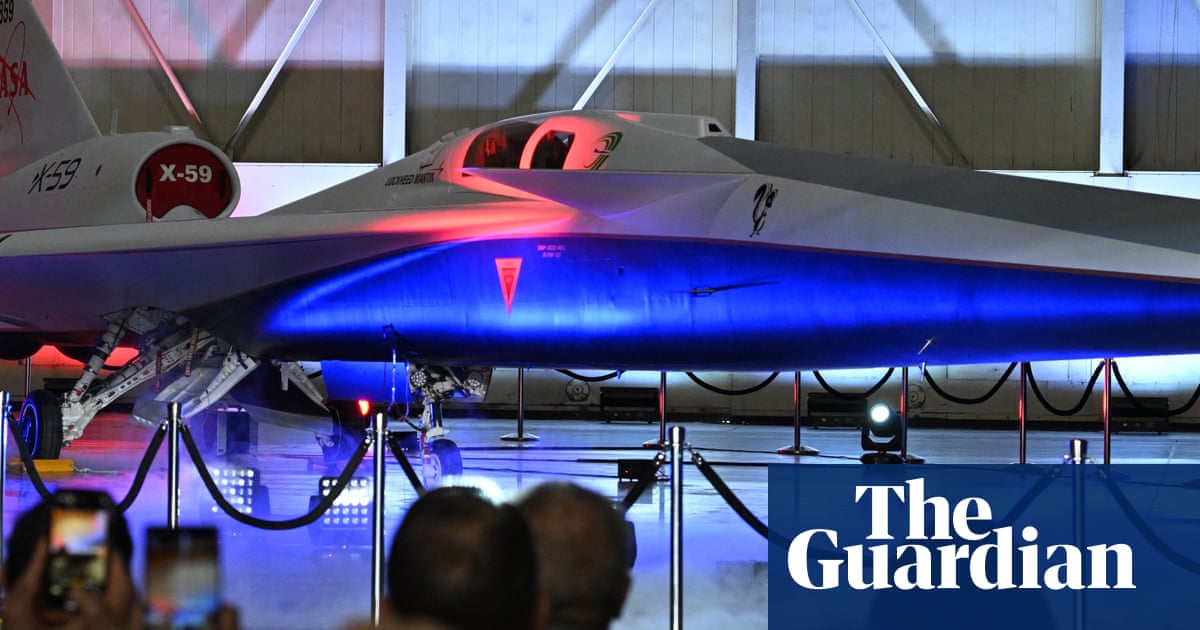- cross-posted to:
- astronomy@mander.xyz
- cross-posted to:
- astronomy@mander.xyz
In launch event on Friday, agency shared plans to test over US cities to see if it’s quiet enough by engaging ‘the people below’
Nasa has unveiled a one-of-a-kind quiet supersonic aircraft as part of the US space agency’s mission to make commercial supersonic flight possible.
In a joint ceremony with Lockheed Martin Skunk Works in Palmdale, California, on Friday, Nasa revealed the X-59, an experimental aircraft that is expected to fly at 1.4 times the speed of sound – or 925mph (1,488 km/h).
The aircraft, which stands at 99.7ft (30.4 metres) long and 29.5ft wide, has a thin, tapered nose that comprises nearly a third of the aircraft’s full length – a feature designed to disperse shock waves that would typically surround supersonic aircraft and result in sonic booms.
pretty neat that the image of the plane for the article is shot from so close that you can only see 1/3 of it, but to be fair it does include the screens of people’s phones as they take a picture of the thing. kind of like going to a concert.
Haha I wonder about the ungodly amount of fuel it burns.
Saudi Arabia is going to love this news.
https://theguardian.com/environment/2023/nov/27/revealed-saudi-arabia-plan-poor-countries-oil
Old news now. The evil in the hearts of humans will be our collective undoing.
I’m not so sure it’s their hearts, those are full of blood. It’s more like a system that incentivises people to make immortal decisions for profit.
The website blasted me in the ass with ads, while simultaneously begging for donations
Yeah but with the pictures on the phones, we actually end up with more picture per picture with this method.
Yo dawg, I heard you like pictures
It’s proportions make it hard to frame it for an article headline picture. This is cropped to show a colorful array of the fun parts: cockpit, landing gear engine intake with a clear X-59. It’s like trying to make a cover picture feature a pencil.
This other article uses a dramatic background to fill the space. It’s from NASA though, so they’re not limited to the conference. They don’t have to have their own picture to say “I was there”
https://www.youtube.com/watch?v=eC3Fl7Bt4qQ
Nasa has a video up now
Please don’t. We need to be reducing air travel, not increasing it. Go invent a quiet supersonic train or something.
the transatlantic railway is feeling less and less like a funny absurdist joke by the hour
That is not said often enough, thank you !
I’m trying to fight the downvoters, you were on -3 when I saw your comment.
Oh bug off! We need faster travel for a long time now!
Being self centered like this is why we’re screwing up our planet.
The planet is fine.
need
Pierce said the X-59’s job would be to “collect data from the people below, determine if that sonic thump is acceptable and then turn the data over to US and international regulatory authorities in hopes to then lift that ban”.
Why can’t commercial airlines fund the project, then? Why is NASA investing public money to deregulate private industry?
Huh? NASA is providing thought leadership to expand the possibilities of human travel, but has no interest in running a commercial airline.
Many technologies you use every day started as NASA research
Why are tax dollars going to something that will only benefit a small percentage of people and will cause relatively bad environmental damage.
Are you aware what NASA stands for?
I personally am happy some of my tax dollars go towards advancing science.
The reason we have issues in society…homeless people, lack of universal healthcare, etc is not because we find NASA, it’s via mismanagement of the funds we have, and bad politics, etc. None of which are NASAs fault or purpose.
NASA does a huge amount of environmental research as well. But part of their team focuses on experimental flight, and this is a product of that.
I’m happy to fund science too, but this isn’t the time to develop even more fuel-intensive commercial travel options.
The first A in NASA is aeronautics. They just do the science. I would say deregulation is a fairly strong word here. It’s more like they’d be updating the laws to reflect modern tech.
This is literally how every expensive R&D project gets done. Private companies won’t dump this kind of money into good R&D, but the government will because they don’t care about ROI.
Except this ignores the existence of bell labs, you know the private R&D lab with ten Nobel prizes and a laundry list of inventions that quite literally shaped our modern world.
deleted by creator
deleted by creator
Deregulate is not the same as engineering a solution to solve the problem that was previously solved by regulations.
The assumption that all regulations are good now, and in perpetuity, is the issue here. Deregulation of shite or outdated regs is a good thing ffs.
It’s insane to me that the word seems so opaque to people.
This is probably defense spending, tbh.
This is outsourced to Lockheed Martin so it’s basically just using Nasa to fund the military even more. There is nothing commercially interesting about this. It’s all military planes.
Well, this might be missile research.
That’s what we really need right now. Faster air travel for fewer people.
But how else will the ultra-wealthy jet over to their summer homes in new Zealand when wet bulb temperatures exceed human survival in the Northern Hemisphere?
Now the fuel efficiency problem needs to be reckened with. The sonic boom was the main reason why supersonic planes were shelved but poor fuel efficiency was the other 800 pound gorilla in the room.
I would be disappointed if the prototype isn’t nicknamed Pinocchio.
Looks to me like a climate change accelerator for rich people. Fewer people per flight, spending more fuel to go faster.
Pleas explain why you think either of those things are true.
Supersonic jets already exist and use dramatically more fuel to carry fewer passengers. Making them not work this way would be an amazing breakthrough that would have merited some mention in the article.
Because of the high fuel use and limited space, this technology will be only used by the ultra-wealthy and will considerably accelerate climate change. It is an absolutely disastrous use of public funds.
the coefficient of drag goes up exponentially the faster you go. As for fewer people, I used my eyes to see that there’s not a lot of room for passengers.
I’m no expert but I’ll take a stab at it. The faster you go the more drag you get on the fuselage that would need to be compensated for with more fuel (unless some neat mechanic helps to mitigate that). Take a look at a conventional jet airplane and you’ll notice it’s capable of holding passengers from nose cone to tail reasonably well due to its cylindrical shape. The X-59’s design has some very interesting geometric features that would give less internal volume for passengers (unless it can be modified to improve for this).
If that’s not reasonable enough then just look at the kinetic energy equation, KE=1/2mv^2. Compared to a velocity of a jet airliner going at 900km/hr versus this plane’s Mach 1.4 (roughly 1500 km/hr) it takes roughly 2.78 times more energy to move a vehicle at that speed (not accounting for drag, energy efficiency, etc.). Is it worth spending roughly 2.78 times more fuel to get to a place 1.67 times faster?
Not OP:
The more you try to fly faster through any fluid (like earth’s atmosphere) the more drag you face. Hence you need a lot more energy (orders of magnitude more, possibly exponentially more). This equates to more fuel burn.
Also since you are going supersonic… you really cannot build big. Also, these things are quite expensive to build, maintain and run. Hence only the top 1% of folk could afford to fly in these things.
Please explain why you don’t think either of those things are true.
well, that’s 5 answers and no reply from you, i assume you’re busy campaigning to ban short-haul flights?
.
This is pretty amazing! This thing could take people from Los Angeles to NYC in 3 hours. The science behind the noise baffling is really cool.
This design may minimize the sonic boom, but that boom cannot be eliminated. “Artist’s impression” image shows … absolutely no room for passengers. This is a design test aircraft focused solely on minimizing shockwave noise. Any passenger plane based on this design is going to be very low capacity, and wholly unable to pull up to a jet bridge at any airport.
This is a technology demonstrator to understand the acoustics of sonic booms. Passenger versions would likely look very different, just incorporating the information gathered from this project.
Why, that is exactly what I said!
No, you said it wouldn’t work as a passenger aircraft. You sound like a naysayer.
No, you said it wouldn’t work as a passenger aircraft.
I said no such thing. What I said was:
Any passenger plane based on this design is going to be very low capacity, and wholly unable to pull up to a jet bridge at any airport.
Actually, a lot of people including me would naysay even if it is viable. Because this stuff is for rich wankers who don’t need another excuse to burn down planet earth in their search for the next money making scheme.
Any passenger plane based on this design is going to be very low capacity, and wholly unable to pull up to a jet bridge at any airport.
I was addressing this, that passenger designs based on this design may not look anything like this airplane. So the constraints of the demonstrator won’t necessaraly carry over to the actual vehicles.
In order to minimize sonic booms, the design must feature an incredibly long, thin nose. That’s what precludes such an aircraft from pulling up to a gate. There’s just not enough room.
If such a passenger plane goes into production, it would need to be hand in hand with airport redesign, and the aircraft would still have a low passenger capacity. Any passenger aircraft with a reasonable capacity would need to be enormous. It’s going to use more fuel to get to M1.4, which will still keep ticket prices high. That means these will be for wealthy people only, if they’re even economically feasible at all.
Please explain why you think that principles learned here cannot inform designs at scale. Do you think it’s the small size of the aircraft which reduces the sonic boom?
To be fair about the jet bridge thing, I’ve definitely been at some pretty major airports (read “SeaTac”) and gone out onto the concrete to board a small plane. The jet bridge is not a deal breaker










